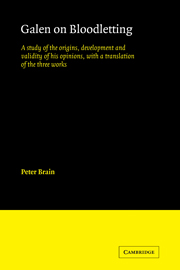 Galen on Bloodletting
Galen on Bloodletting Book contents
- Frontmatter
- Contents
- Preface
- Note on abbreviations and references
- Note on manuscripts and editions
- 1 Galen and his system: an introduction
- 2 Galen's Book on Venesection against Erasistratus (translation)
- 3 Galen's Book on Venesection against the Erasistrateans in Rome (translation)
- 4 Galen's Book on Treatment by Venesection (translation)
- 5 Development of Galen's views and methods as shown in the three works
- 6 Galen, venesection and the Hippocratic Corpus
- 7 Galen's practice of venesection
- 8 Galen's revulsive treatment and vascular anatomy
- 9 The testimony of other writers and the validity of Galen's opinions on sites for venesection
- 10 Galen's use of venesection as an evacuant: can it be justified? A medical digression
- 11 Conclusion
- Glossary
- Works cited
- Index
7 - Galen's practice of venesection
Published online by Cambridge University Press: 04 August 2010
- Frontmatter
- Contents
- Preface
- Note on abbreviations and references
- Note on manuscripts and editions
- 1 Galen and his system: an introduction
- 2 Galen's Book on Venesection against Erasistratus (translation)
- 3 Galen's Book on Venesection against the Erasistrateans in Rome (translation)
- 4 Galen's Book on Treatment by Venesection (translation)
- 5 Development of Galen's views and methods as shown in the three works
- 6 Galen, venesection and the Hippocratic Corpus
- 7 Galen's practice of venesection
- 8 Galen's revulsive treatment and vascular anatomy
- 9 The testimony of other writers and the validity of Galen's opinions on sites for venesection
- 10 Galen's use of venesection as an evacuant: can it be justified? A medical digression
- 11 Conclusion
- Glossary
- Works cited
- Index
Summary
It has been shown in the previous chapter that although the Hippocratic writers unquestionably made use of venesection, they mention it only briefly and in passing, neither offering a rational explanation for its use nor listing the indications. Galen is more systematic. From a study of all his references to venesection it is possible to extract a good deal of information on his practice, and to determine not only what he did but also sometimes why he did it. His indications will be considered first.
In brief, Galen regards venesection as an evacuant remedy to be used in certain patients with plethos, though not in all. Suppression of wonted evacuations of blood, such as the menses or bleeding piles, may lead to plethos, which in turn, if not dispersed, may result in inflammation. Apart from these considerations, any severe disease is an indication for venesection, not only when established, but even when foreseen or expected; thus venesection may be used prophylactically in healthy subjects. Galen employs the remedy widely in fever. It is further used as a revulsive or derivative remedy, to direct blood away from or towards a particular part; and a number of pathological conditions are specifically mentioned in which it is applied. These indications will now be considered in more detail.
As an evacuant, Galen says, venesection is selective; it empties only the veins, whereas starvation leads to the evacuation of the whole body, a process attended with many troubles for the patient. Besides, venesection acts at once, whereas starvation is slow and the weakest of all evacuant remedies; Galen remarks later that it does not evacuate directly at all.
- Type
- Chapter
- Information
- Galen on BloodlettingA Study of the Origins, Development and Validity of his Opinions, with a Translation of the Three Works, pp. 122 - 134Publisher: Cambridge University PressPrint publication year: 1986


